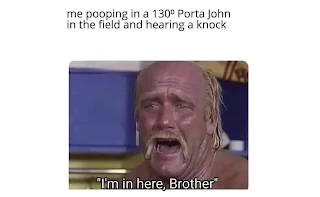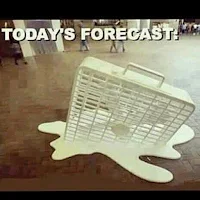How to
Survive the Jobsite During a High Heat Advisory
Indiana summers don’t play fair. They don’t ease in gently
or follow predictable patterns. They lurch between extremes like a caffeinated
raccoon behind the wheel of a bulldozer. But while lightning and tornados make
for dramatic headlines, the real silent killer on the jobsite is extreme heat.
At Calumet Lumber, we know a thing or two about rough
conditions. We’ve been around since 1906, so yeah—we’ve seen some stuff. But
one thing we’re not interested in seeing? Anyone passed out next to a stack of
cribbing because they thought drinking a Mountain Dew instead of water was
“close enough.”
When the High Heat Advisory hits, it’s not just an annoying
notification on your weather app—it’s a warning that the very air around you
wants you unconscious. Working outside in this kind of heat without a game plan
is like trying to outswim a riptide because you "lift on the
weekends." Bold, stupid, and probably fatal.
High Heat Hazards: The Silent Jobsite Assassin
Let’s get one thing straight—heat illness doesn’t give a
damn how tough you are, how long you’ve been in the trades, or how many summers
you’ve “powered through.” It's not impressed by your work ethic or your ability
to ignore basic biological warning signs. It just wants your core temp over
104°F so it can knock you flat before you finish your next cut.
Here’s a badass stat for you: From 2011 to 2020, 344 workers died from heat
exposure in the U.S.—and thousands more were seriously injured. (OSHAs got the body count, in case you
thought we were joking.) Most of those
deaths? Preventable. But hey, nothing screams "preventable tragedy"
like someone saying, “I’m fine,” right before faceplanting into a pile of OSB.
□ Heat Exhaustion is your body throwing up a flare
that says, “Hey, buddy… we’re overheating.” You’ll feel dizzy, weak, nauseous,
maybe even confused. Think: bad hangover without the party.
□
Heat Stroke is the boss level. It hits fast,
shuts down your ability to sweat, and cooks your brain like it’s on a grill at
a Fourth of July cookout. If you hit this point and nobody acts fast? It’s
lights out.
□ □ Cramps that feel like your calves are staging a mutiny
□ □ Skin that’s hot, red, and dry (or ice-cold and clammy, which is also a horror show)
□ □ Rapid pulse, vomiting, passing out, or babbling like a maniac about 2x4 dimensions that don’t exist
You don’t want your coworkers finding you unresponsive under a ladder while your body turns into a cautionary tale. Bottom line: Heat doesn’t tap you on the shoulder. It sucker punches you while you’re busy trying to finish the job. The only way to win is to take it seriously before it shows up with a shovel and a headstone.
How to Not Die (Still Relevant, Still Important)
1. Hydrate Early, Often, and Without Excuses. Your body isn’t a Gatorade commercial—you can’t run on fumes and pride. Start drinking before you’re thirsty and stick to water or electrolyte drinks. Caffeine and alcohol? Save those for the “bad decisions” category, not your shift.
2. Take Breaks Like It’s Union-Mandated. Shaded rest breaks are a must during high heat. You're not “being soft.” You’re avoiding heat stroke and making sure your organs don’t poach themselves mid-shift. Set timers if you must. Hell, ask the new guy to pretend he's your break bell.
3. Use Cooling PPE. Cooling towels, bandanas, evaporative vests—if it sounds like something your grandma would knit but dipped in science, it probably helps. Wearing the right gear can mean the difference between finishing your shift and faceplanting into a pile of sawdust.
4. Adjust Work Schedules. Supervisors: If you're scheduling the
heaviest lifting for 2:30 PM in full sun, congratulations—you’re writing a heat
illness case study. Shift intense tasks
to the early morning or later in the day.
5. Acclimatize New Workers. Rookies aren’t superhuman—they’re just new. Let them ease into full workloads over a week or so. Otherwise, they’ll crash harder than your Wi-Fi during inventory.
6. Emergency Readiness. First aid kits should include cold packs. Know where the nearest cooling spot is. And memorize this phrase: “Call 911. Now.” You’ll know when to say it—just hope you never have to.
Final Word from the Furnace
We joke around a lot here, because laughter makes the job site bearable. But this?
This isn’t a punchline. Heat illness is deadly.
It doesn’t discriminate, doesn’t give second chances, and doesn’t care how long
you’ve “been doing this.”
Let’s be real: no job is worth dying for. Not a scaffold
build, not a concrete pour, not even the golden unicorn of overtime pay. Heat
illness is no joke—and it doesn’t care if you’re “used to it” or “tough.” All
it cares about is finding the guy or gal who thinks a tan is worth a body temp
of 106°F.
At Calumet Lumber, we pride ourselves on being built tough—but not stupid. We’ll fight through rain, snow, and bureaucratic nonsense, but heat stroke? That’s not a badge of honor. It’s a preventable disaster. We’ve outlasted depressions, recessions, fires, floods, and some really questionable flannel trends—but not because we were reckless. We’re still here because we learned from what tried to kill us and refused to let pride outrank survival.
So, let’s be clear:
- Your
life > that deadline
- Your
health > “being tough”
- Your
tomorrow > proving you’re invincible today
So, during these scorched-earth summer days, let’s all agree
to drink water, slow down, watch each other’s backs, and leave the heat stroke
for the amateurs. The kind of legacy we’re building here doesn’t come with
memorial plaques. It comes with smart workers who live to clock in tomorrow.
Stay sharp. Stay standing. And for the love of OSHA—stop pretending you’re fine when your face is melting off. Because around here? We build things that last. And that includes our people.
🔥 OSHA Heat Illness Prevention Checklist🔥
“Because dying of heat stroke is not a great retirement plan.”
☀️ BEFORE THE SUN TURNS YOU INTO A BAKED POTATO ☀️
Create a Heat Illness Prevention Plan
Train Your Crew (Yes, Even the Guy Who ‘Knows Everything’)
Heat exhaustion vs. heat stroke (one makes you woozy, the other makes you dead)
When to hydrate (spoiler: all the damn time)
What to do when someone starts seeing stars that aren’t OSHA certified
Where to find shade that isn’t just standing behind a forklift
Provide Water
1 quart per person per hour
Cool, clean, close by
If your hydration plan is “they can bring their own,” congrats—you’ve failed already.
Provide Real Shade
Ease People In (Acclimatization, Baby)
🔨 WHEN THE SUN IS COOKING YOUR EYEBALLS🔨
Hydration Breaks—Non-Negotiable
Rotate the Workload
Use Work/Rest Cycles
Monitor Your Crew (No Zombies Allowed)
Let Them Dress Smart, Not Macho.
🚑 WHEN IT GOES SIDEWAYS (AND IT WILL IF YOU IGNORE THIS LIST) 🚑
Call 911. Immediately.
- Heat stroke is not a “walk it off” situation. It’s a life-threatening emergency.Confused? Vomiting? Seizing? Call. The. Damn. Ambulance.
Cool Them Like You’re Putting Out a Fire
- While EMS is on the way:
-
Move them to shade
-
Strip off excess clothing (yes, it’s awkward—get over it)
-
Ice packs on neck, armpits, groin
-
Cold, wet rags, fans, mist—whatever it takes
-
And don’t leave them alone unless you’re into hauntings
-








%20397-0254%20sales@CalumetLumber.com%20www.CalumetLumber.com.jpg)
No comments:
Post a Comment